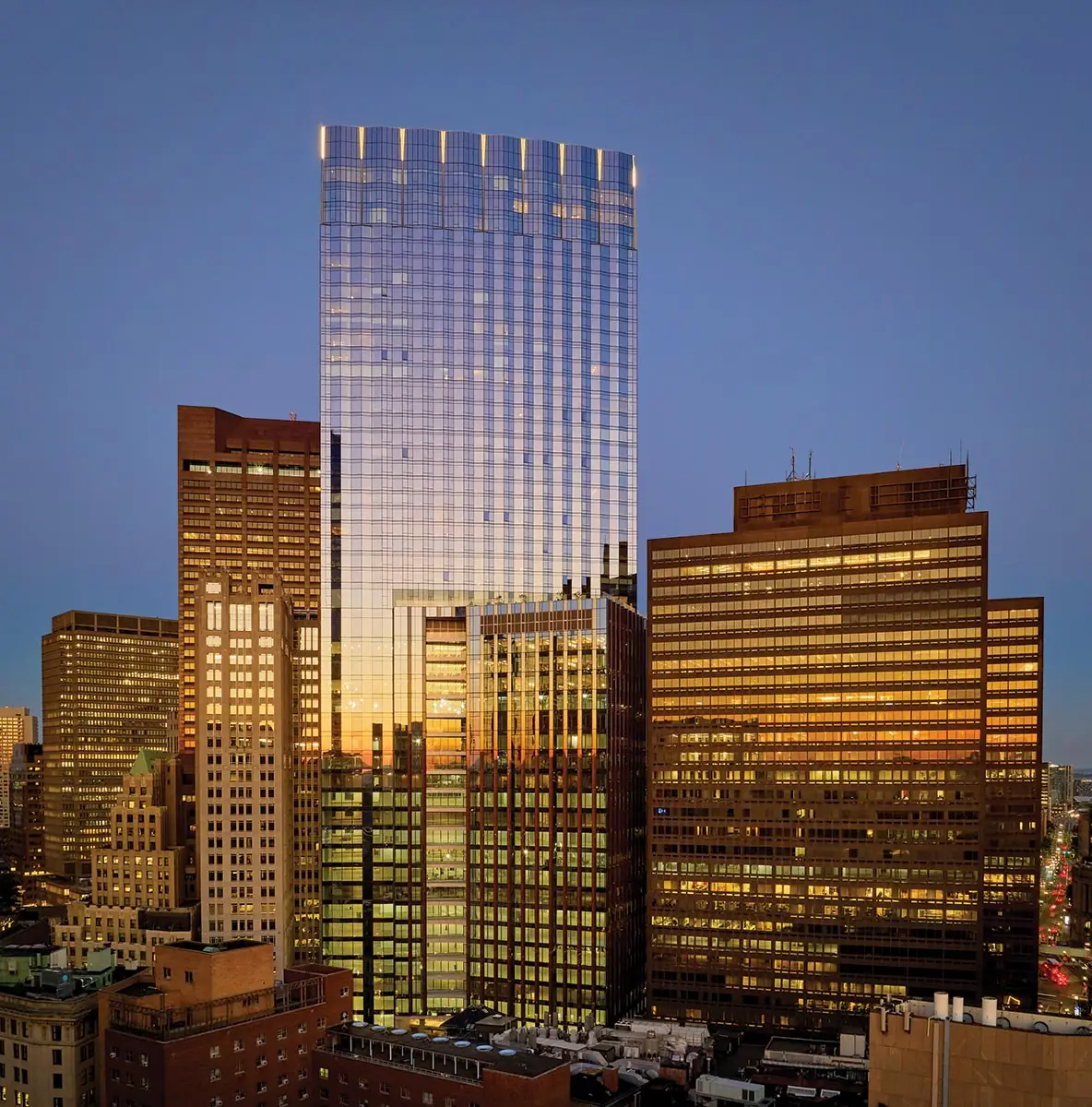Will Boston’s Winthrop Centre be a model for Passive House?
The Winthrop Centre in Boston, designed by Handel Architects in collaboration with Steven Winters & Associates, SOCOTEC, and WSP, represents a paradigm shift in sustainable high-rise construction. As the largest Passive House-certified office building in the world, it combines cutting-edge energy efficiency with modern architectural innovation. This ambitious project is not only a significant milestone in sustainable design, but also a testament to Boston's leadership in addressing climate challenges through advanced urban planning and development, writes John Ridgeway.
The concept for the Winthrop Centre originated in the mid-2010s, with formal planning beginning around 2016. Located in the heart of Boston at 115 Winthrop Square, the project sought to transform a long-vacant site into a vibrant mixed-use development. Groundbreaking occurred in 2018, with the goal of creating a 691-foot tower encompassing approximately 1.8 million square feet of office, residential and public space.
The project was completed in late 2022, with the office portion gaining recognition for its adherence to Passive House principles. This certification was a landmark achievement, as it required the building to meet rigorous standards for energy efficiency, air quality and thermal comfort. The residential and public spaces also reflected the same commitment to sustainability, creating a cohesive design that emphasised environmental stewardship and occupant well-being.
Looking ahead, the Winthrop Centre is poised to serve as a model for future developments, both in Boston and worldwide. It will continue to influence urban design by showcasing the feasibility and benefits of large-scale Passive House implementation - and its advanced systems and innovative design principles are expected to inspire further adoption of sustainable practices in commercial construction projects.
We can see that the global construction industry is now increasingly embracing Passive House standards for high-rise developments. This trend reflects a growing commitment to energy efficiency, sustainability and occupant comfort in urban architecture. In the United States, Massachusetts has been at the forefront of this movement. The state has mandated Passive House standards for large multifamily dwellings, promoting energy-efficient construction practices. This policy shift has led to a surge in Passive House projects, including other high-rise residential buildings that prioritise minimal energy usage and enhanced resilience against extreme weather events.
Internationally, cities like New York have witnessed a rise in Passive House-designed structures. The approach, which originated in Germany in 1991, focuses on significant energy savings through techniques like continuous insulation, airtight sealing and advanced windows. Projects utilising these principles consume 50-80% less energy than conventional buildings. The movement's growth is driven by increased climate change awareness, government support and advancements in technology, extending its application to larger structures, including offices, schools and hospitals.
While specific high-rise buildings achieving Passive House certification post-Winthrop Centre may not be extensively documented, the global trend indicates a significant shift towards adopting these standards in large-scale developments. This evolution underscores the construction industry's commitment to sustainable and energy-efficient building practices, setting new benchmarks for future high-rise projects worldwide.
That said, achieving Passive House certification for the Winthrop Centre’s office portion is a rare achievement in high-rise developments. Passive House is a rigorous energy efficiency standard that emphasises a building’s ability to maintain comfortable indoor temperatures with minimal energy use.
This has been achieved by focusing on airtight construction to deliver a building envelope meticulously designed to minimise air leakage. This has reduced energy loss and enhanced indoor temperature stability, significantly lowering heating and cooling demands.
Furthermore, high-performance insulation in the walls and roofs ensures that heat transfer is minimised. This helps maintain consistent indoor temperatures, regardless of external weather conditions. Triple-glazed windows with low-emissivity coatings also contribute to the building's energy efficiency. These windows reduce heat transfer and improve acoustic performance, ensuring a quiet and comfortable environment for occupants.
Ventilation with heat recovery
Advanced ventilation systems incorporate heat recovery, ensuring that fresh air is continuously supplied without significant energy loss. This enhances indoor air quality while maintaining energy efficiency. The overall design also addresses potential thermal bridges, areas where heat could bypass insulation. By minimising these weak points, the building achieves superior energy performance. When all put together, these features allow the building to consume 60-75% less energy compared to traditional office towers, making it a benchmark for sustainable high-rise construction.
The Winthrop Centre is not just an office tower - it’s a dynamic, mixed-use development that seamlessly integrates public, residential and commercial spaces. The building comprises of approximately 800,000 square feet of office space, designed to meet Passive House standards. These workspaces prioritise natural light, air quality and thermal comfort, contributing to employee well-being and productivity.
The tower includes luxury residences with access to energy-efficient systems, ensuring sustainable living without compromising on comfort or aesthetics. A central feature of the building is The Connector, a two-story public space designed to foster community engagement. It serves as a pedestrian-friendly hub, connecting the Financial District with the surrounding urban fabric. The Connector also includes retail spaces, cultural venues and areas for the public.
The Winthrop Centre also provides numerous amenities, including fitness centres, lounges, and conference facilities, all designed to enhance the user experience while maintaining energy efficiency.
Why is Winthrop different?
While many high-rise buildings incorporate sustainable features, few achieve the comprehensive energy performance of the Winthrop Centre. Its Passive House certification is unique for a building of this size and complexity, setting it apart as a leader in energy-efficient design.
Traditional high-rises often rely on glass facades and centralised HVAC systems that consume significant amounts of energy. In contrast, Winthrop Centre’s building envelope and systems are optimised for efficiency, reducing energy demands and carbon emissions.
The building prioritises indoor air quality, natural light and thermal comfort, creating healthier and more productive environments for its occupants. This focus on well-being distinguishes it from conventional office buildings, which may not emphasise such holistic design principles.
The inclusion of The Connector also demonstrates a commitment to community engagement. This public space transforms the building into more than just a workplace or residence - it becomes a vibrant part of the city’s social and cultural landscape.
The Winthrop Centre is a direct response to the challenges posed by climate change and urbanisation. Its design aligns with Boston’s broader sustainability goals, including the city’s Carbon Neutral 2050 plan. By significantly reducing energy consumption and operational emissions, the building contributes to the city’s efforts to combat climate change.
The project also addresses urban challenges such as pedestrian connectivity and public space accessibility. By integrating The Connector, the building enhances walkability and fosters a sense of community in the densely populated Financial District.

All this means that the Winthrop Centre’s success has significant implications for the future of urban development. As the largest Passive House-certified office building, it proves that energy efficiency and sustainability can be achieved at scale, even in complex, mixed-use projects.
The building serves as a model for cities worldwide, demonstrating how Passive House principles can be integrated into high-rise developments without compromising functionality or aesthetics. Its success may encourage other developers to adopt similar approaches, accelerating the transition to sustainable urban environments.
In short, this is a transformative project that redefines what’s possible in high-rise design. By achieving Passive House certification, it sets a new standard for energy efficiency, sustainability and occupant well-being. Its innovative features, from airtight construction to advanced ventilation systems, also demonstrate the potential for large-scale energy-efficient design in urban environments.
As a mixed-use development, the building integrates residential, commercial and public spaces, enhancing community connectivity and fostering a sense of place. It aligns with Boston’s climate goals while addressing broader urban challenges, making it a beacon of sustainable development for cities around the globe.
Looking ahead, the lessons learned from the Winthrop Centre will continue to shape the future of architecture and urban planning, proving that sustainability and innovation can go hand in hand. Whether through its pioneering design or its role in inspiring future projects, the Winthrop Centre stands as a symbol of progress and a blueprint for the buildings of tomorrow.
Additional Blogs

What if Building Control went fully digital?
Building control governs structural integrity, fire protection, energy efficiency, accessibility and countless other aspects of design and construction. Historically, this process has been highly...
Read moreWhere most “Smart Buildings” go wrong
Smart buildings are often presented as the ultimate in modern construction - interconnected, efficient, intuitive and driven by real-time data. They promise lower operating costs, reduced energy use,...
Read more

The future of facilities management starts at RIBA Stage 0
Facilities management has traditionally been treated as a discipline that only becomes relevant once a building is handed over. At that point, FM professionals inherit decisions made months or years...
Read more